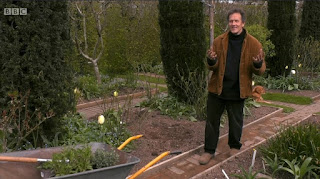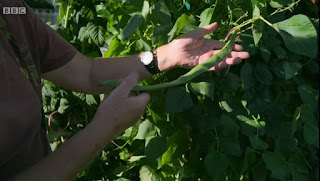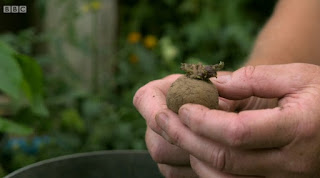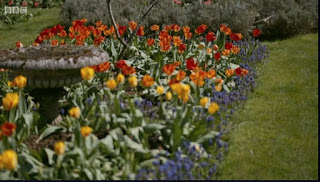
Monty Don welcomes us to Gardeners' World 2021 Episode 5 and he is busy filling up the bare spaces left in the Jewel and Cottage garden left by the removal of the Box Hedges.
Now is the time to move Herbaceous plants and he is transplanting a Echinops Ritro, which grows to 3 foot tall with spiky flowers, from another part of the garden.
He wants it to follow on after the Roses have stopped flowering and he tips it gently out of the pot and it has a strong root system.
Presenters

Monty is in the cottage Garden and he has some new plants to compliment his Roses which need good ventilation and light so cannot be crowded.
The first plant he is planting is Nepeta Catmint the variety is Walker's Low which likes full sun and when it is cut back hard it will regrow and re-flower.
Next plant is a Salvia Caradon which will cover the bare branches at the Roses base and the final plant is a spreader Geranium Rozanne which flowers from Summer to Autumn.
Monty in his potting shed with a tray of Cactus flowered mixed Dahlias he sowed 3 weeks ago along with the viewers and now is the time to move them on.

Each one needs to go in a separate container and they need to be held by the leaf to then gently prise out the seed by digging round it.
He pops it in a pot and adds more compost and gives them a water and there is still time to sow some more.
Monty is raking over a vegetable bed ready to sow some Parsnips Tender and True and the soil needs to be warm to the touch and he sprinkles the seed very thinly.

In the same drill as the Parsnip he is growing a Radish called Ravanello as the Parsnip are so slow to germinate.
Next its Carrots and Nantes is the variety and because of Carrot Fly he tries to sow them as thinly as possible to stop the need for thinning out.
If its very dry give them a water so the seed is in contact with the soil.
Blueberries are usually grown in pots as they need an ericaceous soil and Longmeadow soil is neutral so they will survive but not do well.
Monty has created his own ericaceous mix which he top dresses them with. You can also buy commercial ericaceous compost made from bracken and you can also get one made from pine.

He also has ash from the fire that he puts on top that helps them to flower and produce fruit and then adds a layer of composted bracken.
You cannot change your soil so container growing is the best way to make sure the plant get what soil type it needs.
The Daffodils at the Cricket Pitch are starting to go over and the seed heads are forming behind the flowers and if they are in a pot or border you need to snap these off.
The green stem will then photosynthesize and take all the goodness from the sun into the bulb for next years flowers.
If they are grown in long grass its best to leave the seed heads so they spread and you get more.
For the first time Monty planted some Tulips Tulipa Praestans Shogun in the Cricket Pitch and flowered really early in March.
Monty often gets asked when is the best time to prune Hydrangeas and as there are different types and different times to prune.

Most Hydrangeas Like Lacecaps and Mopheads the time for pruning is now.
They are susceptible to frost so the flowerheads protect them so now you need to cut off those flowerheads and you cut back to just before a flower shoot.
They do not like being dry and if you have an established plant you should also prune off some off the old growth right to the ground.
Most Hydrangea flowers are on last years growth but Hydrangea Paniculata that produces flowers on new growth.
If you are not sure just do not prune and wait an see what the flowers grow on.
Monty is amazed at the weird Imperial Fritillaries variety Fritillaria Imperialis Rubra Maxima and their relationship with Blue tits because they pollinate them!
The birds are after the nectar and then spreads the pollen and Monty loves to watch them.
Monty in the Orchard where they are making a wild flower meadow and they have lots of Daffodil and Tulip bulbs, Camassias and lots of Annuals and Perineal to come.
He sowed Yellow Rattle to stop the grass growing so strongly but there is a problem and Wild Flower Meadows are not easy.
One plant is causing a problem and that is Common Hogweed which flowers a bit like Cow Parsley which will spread and blanket everything else out.
Giant Hogweed grows to 15 foot high and the sap can cause nasty burns and if you have that you need to inform the authorities and have it removed.
The Common Hogweed can cause burns but is less likely too so you should handle it with gloves.
He has so many he is going to dead head them so it does not seed everywhere as there are too many to dig up.
Monty says you don't need a wildflower meadow for Umbellifers.
His beds were cut out in the long grass around 6 years ago and they have been planted and he wants to link these beds with the Wild Flower Meadow.
So he is going to plant various kinds of Umbellifers that you can buy in garden Centres or Nurseries as plug or small plants.
He is planting Anthriscus Ravenswing with is a purple foliage Cow Parsley which will have a pinky white flower.
Next some wild Carrot, Daucus Carota which looks very decorative and then a perennial Umbellifer called Selinum or Milk Parsley which will grow in any garden.
He also has some Ammi Majus he sowed last year which you can buy as a plant as too late to sow and also Ammi Visnaga which you can sow now.
Monty last job this week is in the Jewel Garden where he is digging up Allium Purple Sensation which is a beautiful plant and 25 years ago they planted 100 bulbs.

It has spread with a vengeance so he is digging some up as next week he is planting an evergreen hedge so you need to get rid of weeds etc a week before to check for regrowth.
McBean's Nursery

Jim Durrant has been breeding and growing Orchids for 50 years and the Nursery was first founded in 1879 and imported plants from Northern India in the Himalayas and South America.
From those initial plants they have been breeding and they can all be traced back to the original plants.

The type they mostly grow are Cymbidiums which are cool growing and suit our climates and can go out in the garden in the Summer.
He has known some of the pants for 50 years and then their always new hybrids to look after.
He bred his first plant in 1975 Highland Canary and its parents were Mavourneen Jester and Cariga Canary.
It takes 6 years from seed to flowering for a new plant so it was big event for his first plant.
You water them when they are dry and they should never sit in water, better to be too dry than over watered.
They also grow Oncidiums and he shows us a Oncidium Alexandra and it is over 100 years old and is used for breeding.
The different generations that are 20 years apart show how the flower changes to get the final full flowered one, now it is more popular to have a smaller flower so they are back to the original one.

The Orchids have lips so the bee can get in to pollinate right inside the flower and they carry out the pollen and rub it on the flower when they go in and out.
Orchids are so popular and are a tougher plant than most people think and they prefer rainwater with an orchid feed and they like being in tight pots.
Gerald & Liz Stratford

Gerald and Liz live in Chipping Norton and they love their garden which they are out in every day.
They have had the garden for 4 years and Gerald does the vegetables and Liz looks after the flowers.
He shows us his beans which are a variety called Guinness World Record as they grow very large.

He used to fish but gave it up to concentrate 100% on the garden as he has to do his best.
Gerald has some huge onions he grows outside but brings them into the greenhouse to ripen off or dry out and they are very mild and tasty.
He likes his root vegetables as it is not until you lift them you can see how you have done.

He is known locally as the Potato King as he loves them and tells us there are 3 types First Early, Second Early and Maincrop.
He is tipping out a pot of Pink Fir Apple potatoes which is a maincrop.

To store potatoes they need to be dry and he buy proper potato storage sacks as no light can go in the bag.
He uses horse Manure, composted turf and his green manure as his magic ingredients.
Gerald is tipping out another Maincrop potato Red Emmalie and they are red all the way through.

It takes 110 days for a Maincrop potato to grow and are harvested in August and September.
He digs up some more Sarpo Mira and he already got some potatoes chitting for Christmas and they are a favourite of his Charlotte.
He has also put them in the fridge for 2 days to start them thinking its now spring and he places them in a bucket with the shoots upwards.

He then fills the bucket to 1 inch from the top and gives them a water.
Liz says it is her happy place and Gerald says he loves his veg and they are his friends.

Carol is at Dunsborough Park in Surrey to see their fantastic collection of tulips which she says makes you happy and are one of out most popular bulbs.
They come in so many colours and types and enmasse they are breath taking.
They are a member of the lily family and there are 75 species and a lot more hybrids and are divided into 15 groups.

The groups have names like Triumph, Darwin, Double Early which is because of differences in flower size, form, structure and habit.
We have cultivated tulips but originally they lived in the mountains of China along the Tian Shan range which has freezing Winters and very hot Summers.
The more our conditions are like that the happier our cultivated Tulips will be.
Tulips look good mixed with other plants like the creamy white Tulip Purissima AKA White Emperor with the Daffodil Thalia which is a Triandrus Daffodil plus there are Geraniums waiting to take their places. Overhead there is Wisteria.
The next planting scheme to excite Carol is colour graded from pale yellow, through yellow to orange to end up with fiery red Tulips.

They have done this using Darwin Tulips and forms of Apeldoorn which is a grand tulip and they have also planted Blue Muscari.
This would look lovely in a container, planting both bulbs together then waiting for Spring.
They have the most amazing Tulip Meadow made up of randomly planted Tulips in the grass under some huge Oak Trees.
When people plant Tulips the first year they look great but by the second year people get rid of them as they don't look so good.
What they have done is taken these Tulips and planted them in the Meadow and because they are such a mix the display will go on for a long time.

To grow Tulips successfully you just need to choose good bulbs then choose a very sunny spot to plant them.
They need to be planted deep and if you have heavy soil add grit to the sides as they need good drainage.
Plant them late in December as they will get a cold period and once flowering is over take off the flowering stem and let the foliage die back to feed the bulb for next year.
Tulips love growing in pots so everyone can have them and Carol loves them.
Kate Bradbury

We are going to visit Kate again in her garden in Brighton which she has changed from a normal back garden into a haven for wildlife.
The first thing she did to do this transformation was take out nearly all the shrubs and trees to replace with British native species.
She also put in a pond and made habitat piles, bee hotels and laid a wild flower meadow.

The pond has made a huge difference with the number of birds it attracts as well as hedgehogs but the Meadow is the real centre of the garden.
The meadow is made up of loads of different grasses, Oxeye Daisy and buttercups and even if you have a small patch you can grow a small patch of wildflowers, nettles or Dandelions.

Wildlife gardening is not just growing flowers for pollinators it is a huge part but you also need leaves for caterpillars and other insects to lay eggs.
Caterpillars are at the bottom of the food chain so they not only turn into moths and butterflies but are also food for other species like birds.
In a wildlife garden the plants have to be beneficial and she has a honeysuckle, the native Lonicera Periclymenum which is good not only for Bees but night flying Moths.
The roots need to grow in the shade so her North facing wall is perfect as the leaves will grow up into the sun.
Climate change has changed when Bees and Butterflies are coming out so Bumblebees come out of hibernation very early in January or February.
She has a pollinator border and grows Crocus as they flower early, Winter Aconite, Lavender, Catmint, Rudbeckia, Verbena Bonariensis and Perennial Wallflower so she has flowers across the whole time.
It is important to have lots of different shaped flowers as insects have different shaped mouth parts and visit certain shaped flowers.
Bees with long tongues like Honeysuckle and Foxgloves where as short tongued Bees like Daisies and Cranesbill.
She has as many shapes as possible of flowers from poppies to Campion and Lupins which the long tongued Bees like and she is planting 3 new ones.
Kate says you also have to tolerate Wildlife you do not like as her plant has attracted lots of Aphids but she leaves them as House Sparrows will feed on them and Ladybirds and Hoverflies lay eggs on their colonies and Lacewing also eat them.
So these are all part of the food chain and the garden is her happy place and she likes to stand at the kitchen window and watch it when she not in it.
Viewers Videos
Farida from Wiltshire

They have used tyres and pallets to make seating and a colander lined with a compost bag which she plants Coriander in.

She shows us one she already done with a chimney wire cover and a steel toe cap boot with a Petunia in it.
Emma from London

Emma has her own jungle of houseplants in her top floor flat as she does not have any outdoor space to get close to nature.
She has over 100 and has a greenhouse cabinet for some tropical plants that she can control the humidity for which she keeps between 65 - 80% humid and it also has grow lights plus fans.

Her most prized plant is inside it a Monstera Albo and at first it was grown outside the cabinet but the white leaves turned brown and crispy but its happy now it has the right conditions.
She is also propagating some String of Hearts cuttings in moss and they do well in the humidity.
She has also got a Cissus Discolor which was just a 1 leaf cutting when she got it 2 months ago.
Emma says her houseplants have been her saviour during lockdown when she has not been able to go outside as much as she would like and also has given her something to nurture and focus on.
Morgan from South London

Morgan is an Ecologist who specialises in Urban Biodiversity and he is proud to have a wild flower meadow on his shed roof.
He mixed up his own Substrate of light expanded clay aggregate balls, peat free compost with gravel and grit.
The planting medium is high water retaining but low in nutrients which the wild flowers need to grow.

He created a frame around the shed roof from a pallet and around the border edge he has some Caledonian Cobbles and on top there are also some old woolly jumpers.
Morgan encourages us all to have a mini brownfields meadow on your shed roofs especially if you are short on space.
Patti is standing on the board in the way as Monty sows his Parsnips.

Patti is asleep on the Cricket Pitch and stopped play for the day.
We catch sight of a sleepy Nellie by the Imperial Fritillaries.

Patti running through the long grass in front of the wheelbarrow.

Patti in the Jewel Garden.

Sow Courgettes
Now the time to sow them and place 2 seeds on their edge in peat free compost then water and keep warm on a south facing windowsill.
Cut back Penstemon
When you see new growth emerging at the base and cut back hard getting rid of all last years growth.

Sow Annual Climbers
Annual climbers like Cobaea Scandens and Spanish Flag which make a lovely display in mid to late summer are sown from seed.
Plant them in pots or plugs, water well and pout them somewhere warm to germinate and they will be planted out after the last frost.
All photographs are copyright of BBC.com
Previous Episode 🌱 Next Episode

No comments:
Post a Comment